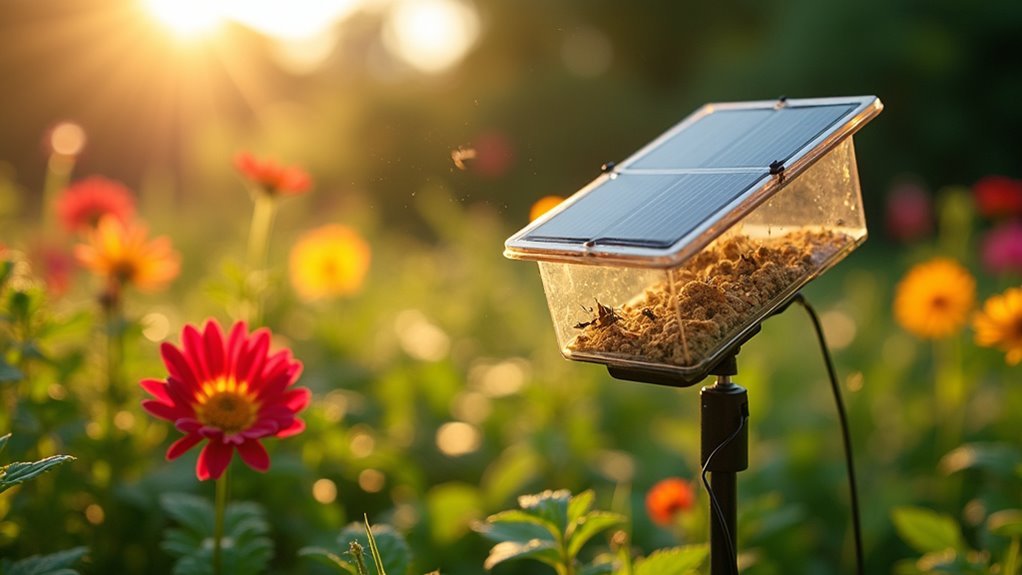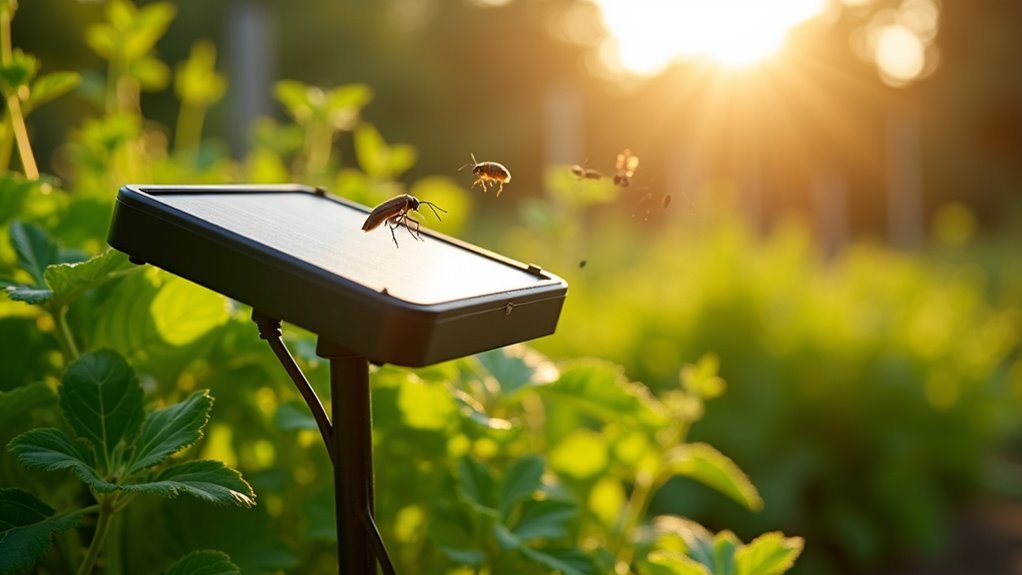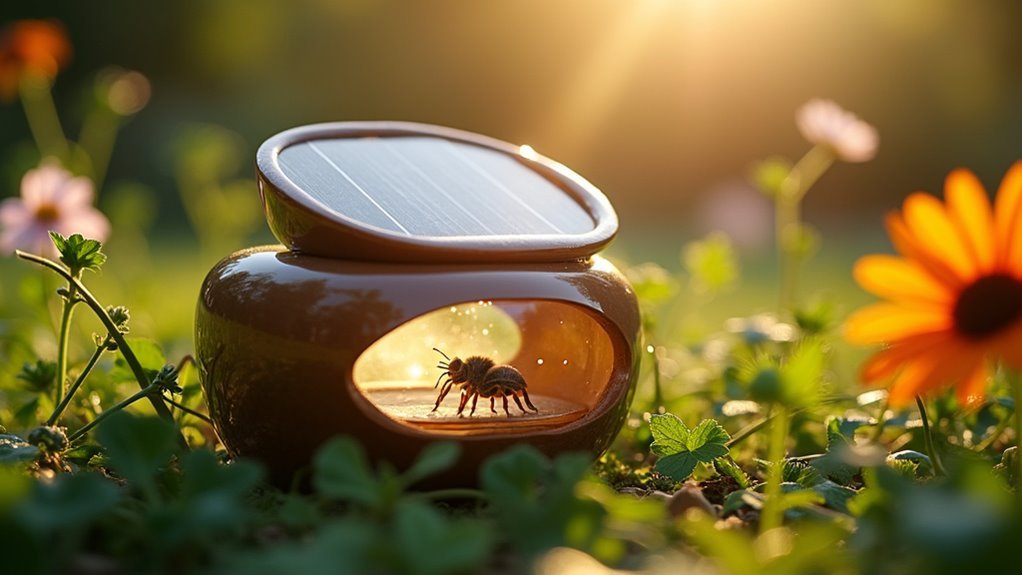You can monitor garden pests automatically with solar-powered traps that harness sunlight to continuously photograph insects on sticky surfaces. These smart systems operate independently for up to nine months, sending real-time notifications to your mobile device when pests are detected. They’ll reduce your labor costs by up to 60% while providing instant pest identification and eliminating frequent garden visits. Discover how these innovative traps transform your pest management approach.
How Solar-Powered Pest Traps Work in Your Garden

Solar-powered pest traps harness sunlight through built-in panels to power automated systems that capture and monitor garden pests without requiring batteries or electrical connections.
These smart devices continuously photograph insects caught on sticky traps, providing high-resolution images that help you identify specific pest species in real-time. The automated adhesive replacement system guarantees your traps remain effective without manual maintenance, as strips refresh themselves when needed.
You can customize these solar powered units for different crops and environmental conditions, targeting particular pests common to your area.
Smart technology integration allows remote monitoring through your smartphone or computer, letting you adjust pest control strategies from anywhere.
This automated approach transforms traditional sticky traps into intelligent monitoring systems that work around the clock.
Key Features That Make Automated Monitoring Effective
While understanding the basic operation helps you appreciate these innovative devices, the specific features that drive their monitoring effectiveness set them apart from conventional pest control methods.
You’ll benefit from high-resolution cameras that capture real-time images, accurately identifying both harmful pests and beneficial insects. The automatic adhesive strip replacement means your sticky trap functions independently for up to nine months without manual intervention.
High-resolution cameras distinguish harmful pests from beneficial insects while automatic adhesive replacement ensures nine months of independent operation.
Remote monitoring capabilities let you access pest data instantly from your mobile device or computer, enabling quick decision-making. Standardized pest identification and counting provide larger sample sizes for analysis, improving management efficiency while reducing your labor costs by up to 60%.
These features transform pest monitoring from reactive guesswork into proactive, data-driven garden management.
Setting Up Your DIY Solar Pest Surveillance System

You’ll need to mount your solar panel in a location that receives direct sunlight for at least 6-8 hours daily to guarantee consistent power for your surveillance system.
Position the panel at a 30-45 degree angle facing south for maximum energy collection throughout the day.
Next, you’ll want to strategically place your camera to capture the trap’s activity zone while making sure the solar panel can adequately power both the trap and recording equipment.
Solar Panel Installation
Once you’ve decided to build your own solar pest surveillance system, selecting the right solar panel becomes your first critical step.
Your solar panel installation requires careful planning to guarantee peak performance and longevity.
For effective solar panel installation, follow these essential guidelines:
- Choose adequate wattage – Select a panel providing 5-10 watts to power your pest traps effectively
- Position for maximum sun exposure – Place your panel where it’ll receive 6-8 hours of direct sunlight daily
- Use weatherproof enclosures – Protect your panel and electrical connections from rain, snow, and debris
- Connect to battery storage – Wire your panel to rechargeable batteries for continuous nighttime operation
You’ll need to regularly clean your panel’s surface and check positioning to prevent efficiency loss from accumulated dust and debris.
Camera Positioning Setup
With your solar panel properly installed and positioned, camera positioning setup becomes your next priority for maximum pest detection coverage.
Mount your camera 6 to 8 feet high to capture a wide field of view while avoiding obstructions from plants and garden structures. Use a mounting bracket or sticky adhesive to secure the camera firmly, guaranteeing it withstands windy conditions and heavy rain.
Angle your camera toward high-traffic pest areas like flowering plants or vegetable beds where insects typically congregate. This strategic positioning enhances detection accuracy and monitoring effectiveness.
Regularly inspect your camera’s alignment and functionality, making adjustments as needed to maintain peak performance. Proper camera positioning setup guarantees your solar-powered surveillance system operates at top efficiency throughout the growing season.
Remote Monitoring Capabilities Through Mobile Devices
You’ll receive instant notifications on your mobile device the moment a pest triggers your solar trap’s high-resolution camera.
The accompanying mobile app lets you identify captured insects immediately and adjust trap settings remotely without stepping foot in your garden.
This real-time detection system puts complete control of your pest management strategy right in your pocket, operating autonomously for up to nine months.
Real-Time Pest Detection
While traditional pest monitoring requires frequent garden visits and manual inspections, solar-powered traps with high-resolution cameras revolutionize this process by delivering real-time images directly to your mobile device or computer.
You’ll receive immediate alerts when pests are detected, enabling quick identification and response.
These autonomous traps transform your pest management approach through:
- Instant notifications when pest activity occurs in your garden
- High-resolution imagery that captures clear details for accurate pest identification
- Continuous monitoring without requiring your physical presence
- Immediate data transmission to your devices for rapid decision-making
You can now respond to pest threats within hours instead of days or weeks.
This real-time capability means you’ll catch infestations early, apply targeted treatments precisely when needed, and prevent minor pest issues from becoming major crop damage.
Mobile App Controls
Because modern gardeners demand flexibility and convenience, mobile app controls put complete trap management at your fingertips, allowing you to monitor and adjust your solar-powered pest detection system from anywhere with an internet connection.
You’ll receive instant notifications when your insect traps detect activity, complete with real-time data and images that help you identify specific pest types immediately.
The app enables remote adjustments to trap settings, letting you customize detection parameters based on environmental conditions and target pests.
You’ll eliminate up to 60% of manual checking time while accessing thorough data analysis tools that reveal pest patterns and trends.
This smart integration transforms your insect traps into a proactive pest management system that works around the clock.
Cost Savings and Labor Reduction Benefits

When traditional pest monitoring demands constant manual checks and labor-intensive maintenance, solar-powered traps deliver a game-changing solution that can slash your labor costs by up to 60%.
These autonomous systems operate for nine months without intervention, eliminating the need for frequent field visits. The LED light automatically attracts pests while solar panels power continuous operation, removing battery replacement expenses.
You’ll benefit from:
- Real-time pest data and images for immediate decision-making
- Automated detection that frees you for other critical farm tasks
- Sustainable operation with zero ongoing energy costs
- Targeted pest control strategies based on accurate population monitoring
This technology transforms pest management from a labor-intensive burden into an efficient, automated process that saves both time and money while improving your operational effectiveness.
Adapting Traps for Different Garden Environments and Pests
Since different garden pests require targeted approaches, you’ll need to customize your solar-powered traps with specific attractants and positioning strategies. For wasps, honey works effectively, while jam attracts moths and other sweet-seeking insects.
Make sure you position traps strategically throughout your garden to maximize coverage.
Automated sticky traps like Trap-Eye™ monitor both harmful and beneficial insects, giving you extensive ecosystem insights. These systems operate independently for up to nine months across diverse garden settings without frequent maintenance requirements.
High-resolution cameras provide real-time images of insect activity, letting you track pest populations and adjust control strategies accordingly.
This technology adapts to various crops and environmental conditions, promoting sustainable pest management practices that respond to your garden’s specific needs.
Frequently Asked Questions
How Long Do Solar Batteries Last During Cloudy Weather Periods?
Solar batteries typically last 3-7 days during cloudy weather, depending on your battery capacity and device power consumption. You’ll get shorter runtime with older batteries or energy-intensive features like frequent data transmission.
Can These Traps Withstand Extreme Weather Conditions Like Hail or Storms?
You’ll find most quality models feature weather-resistant housing that handles moderate hail and rain. However, severe storms with large hail or high winds can damage them, so you should consider protective placement or temporary removal.
What Happens to Trapped Insects During Winter Months or Freezing Temperatures?
Trapped insects typically die from freezing temperatures during winter months. You’ll find frozen specimens preserved inside the trap until spring thaw, when you can empty and clean the collection chamber for next season.
Are Solar-Powered Traps Safe Around Children and Pets in the Garden?
You’ll find most solar-powered traps are quite safe since they don’t use harmful chemicals or electric shocks. However, you should still place them where curious children and pets can’t easily reach or tamper with them.
How Often Do Adhesive Strips Need Replacement in High Pest Areas?
You’ll need to replace adhesive strips every 2-3 weeks in high pest areas. Check them weekly since heavy infestations quickly fill strips with insects, reducing their effectiveness and requiring more frequent changes.
In Summary
You’ll transform your garden pest management by implementing solar-powered traps that work around the clock. You’re investing in technology that’ll reduce your labor costs while providing real-time monitoring through your smartphone. You can adapt these systems to target specific pests in various garden environments, giving you precise control over your pest strategy. You’ll save time, money, and effort while maintaining a healthier garden ecosystem year-round.





Leave a Reply